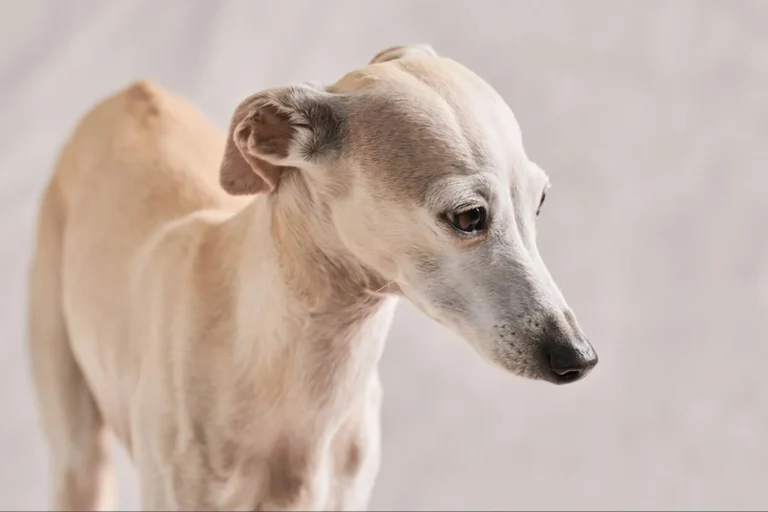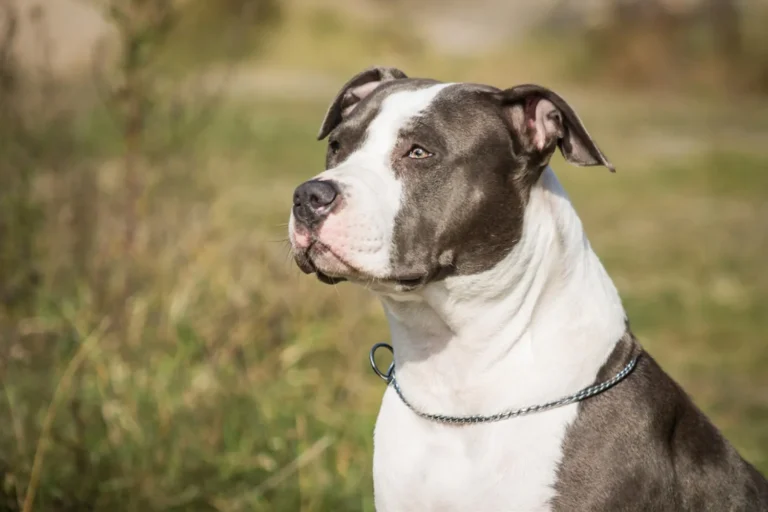
If you’re dreaming of an affectionate, loyal, and wonderfully intelligent family companion, a Saint Bernard might be just the right fit. These gentle giants have a knack for leaning their whole heart (and body) into you my neighbor’s Saint would rest his head on my knee until I caved for cuddles.
Just be ready for big love in a big package: early training helps with their size, regular brushing keeps that plush coat tidy, and a “drool towel” by the door isn’t a bad idea. Give them space, steady walks, and lots of affection, and you’ll have a calm, devoted buddy for the whole family.
History and Origins of the Saint Bernard
If you close your eyes and imagine a snow lashed mountain pass, you’ll land pretty close to where the Saint Bernard story begins: the Swiss Alps, right at the Great Saint Bernard Pass, one of the highest road passes in Switzerland. It’s a place where winter likes to stick around and trails disappear under drifts, and that’s exactly where this breed earned its heart of gold reputation.
The Saint Bernard’s roots reach back to ancient Roman times, when big, sturdy dogs marched with the legions across the Alps. But the breed truly came into its own centuries later with the monks at the Great Saint Bernard Hospice, a refuge for weary travelers. The monks bred powerful, keen nosed dogs to work alongside them first as watch and farm dogs, and then, as their gift for scent and stamina proved unmatched, as lifesaving search and rescue partners. The hospice’s local Italian archdeacon, Bernard de Menthon after whom the breed is named is believed to have kept dogs like these in the 16th century, and his legacy is woven into every Saint’s story.
These dogs became legends not for looks, but for grit and grace. Tales of heroes like Barry, who famously found and aided travelers lost in the snow, turned the Saint Bernard into a symbol of quiet bravery. I remember meeting a retired rescue line Saint at a winter event in Vermont no brandy barrel around his neck, just a calm gaze and paws like dinner plates. He leaned into me like an old friend, and I thought, yes, I can see how you’d make someone feel safe on a stormy night.
By March 1884, the breed’s reputation was so strong that the Swiss Saint Bernard Club formed in Basel to formalize standards. From there, the Saint Bernard stepped into the global spotlight as a gentle giant part rescue hero, part family cuddle bug. A breeder I spoke with once said, “They’re mountain hearts in living room bodies,” and that stuck with me.
If you bring one home, remember those alpine roots. Give them jobs: scent games in the yard, brisk walks in cold weather, a bit of carting if you’re up for it. Keep a towel handy for the drool and a soft bed for those massive joints. Under all that size is a steady, tender soul still listening for a cry in the snow, even if it’s just you calling them in for dinner.
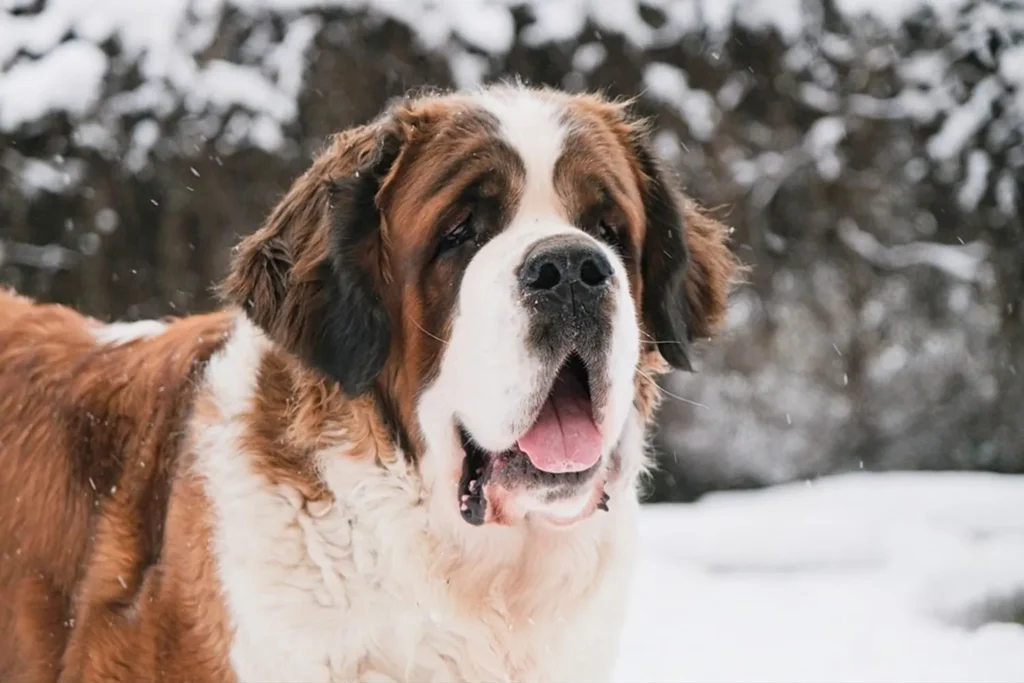
What Is the Saint Bernard Breed?
If you’ve ever locked eyes with a Saint Bernard, you know that look: floppy ears framing a big, thoughtful face, droopy eyes that seem to read your mood, and those striking two toned, mask like markings. Add a massive, blocky head and a thick, warm coat you could practically nap on, and you’ve got a dog that turns heads wherever they go. They may look imposing at first glance, but these dogs are famous gentle giants steady, soft hearted, and wonderfully affectionate.
I remember the first Saint Bernard I met leaning all his weight against my legs like a living weighted blanket. That’s their style. They adore their people and have a natural affinity for children, moving around little ones with a careful, slow grace that always makes me smile. Despite their robust, muscular build, they’re usually calm souls. Think big, mellow roommate rather than nonstop athlete. A couple of relaxed walks, a bit of play, and plenty of family time is their ideal day. With their mountain ready coats, they prefer cooler weather and a shady spot in summer. And yes, keep a towel handy those soulful eyes come with a little drool tax.
Saint Bernards thrive as family pets because they’re loyal and companionship driven. They’re adaptable, too. I’ve seen them happy in spacious backyards and content in cozier homes, as long as they’re included in daily life. My advice: plan for size sturdy bowls, a roomy bed, and clear walking paths plus regular brushing to keep that thick coat in good shape. Start gentle training early; they’re eager to please, but it’s easier to teach polite manners when they’re still “small.” Do that, give them your time and affection, and you’ll have a tenderhearted best friend who’s as comforting as a hug on four paws.

Who Is a Saint Bernard Best For?
If you dream of a giant, gentle shadow who pads after you from room to room and leans his whole heart (and considerable weight) into your legs, a Saint Bernard might be your perfect match. They’re famously friendly and steady, the kind of dog who greets guests like old friends and settles at your feet once everyone’s accounted for. I once watched my neighbor’s Saint, Gus, patiently “babysit” by lying on the playroom rug while a toddler drove toy cars over his back. Of course, supervision is a must with any dog and child, but Saints do tend to be wonderfully tolerant and deeply bonded to their families.
Despite their size, they don’t need a mansion or a private garden to thrive. What they do need is daily routine and your company. Plan for at least 30 minutes of outdoor exercise, plus a few relaxed “sniffari” strolls or backyard potters if you have space. They’re not marathon runners; they’re moseyers. When I was dog sitting a Saint named Moose, two short walks and a slow evening loop around the block suited him perfectly then he’d curl up (okay, sprawl) by the sofa. Apartment living can work if you’ve got enough room to turn around without stepping over a tail and you’re consistent with walks. Just be mindful of lots of stairs, especially for growing pups and seniors.
Now, a friendly warning to neat freaks: Saints come with accessory items called hair and drool. They shed year round with seasonal “snowstorms,” and grooming takes commitment regular brushing, and extra sessions during big sheds. I keep a “drool towel” by the door after a certain Saint decorated my jacket with a string of slobber just as I headed to a wedding. Water bowl splash zones, fur tumbleweeds, and nose art on windows are part of the package. A good vacuum, washable throws, and a sense of humor go a long way.
Because of their thick coats and bulk, Saints are happiest in cooler climates. Heat management is essential. If you live somewhere warm (hello, Australia), think early morning and late evening walks, plenty of shade, constant fresh water, and cooling mats. A friend in Queensland swears by a kiddie pool on the patio her Saint would wade in and refuse to come out until dinner. Avoid midday outings and keep indoor temps comfortable; these dogs can overheat faster than you’d expect.
Training matters size amplifies everything. A joyful paw on your thigh becomes a full body shove when it belongs to a Saint. Start leash manners, polite greetings, and basic cues early, and consider a positive reinforcement trainer. They’re protective without being pushy; the sheer size and a single “woof” usually convince strangers to keep it moving. First time owners can succeed if they’re committed to learning, but be honest about the time, strength, and consistency this breed needs.
Practical bits people forget: budget for big dog supplies (giant bed, sturdy harness, family sized food sacks), make sure your car can actually fit your co pilot, and plan how you’ll manage steps and slick floors. Slow feeders can help with tidy mealtimes, and wiping jowls after water breaks cuts down on the post drink monsoon.
Bottom line: a Saint Bernard is ideal for families or individuals who want a tender hearted, calm companion and gentle home guardian, and who are happy to trade pristine floors for snuggles the size of a small bear. If you can invest in grooming, moderate daily exercise, thoughtful training, and lots of together time, a Saint will give you loyalty and love in truly jumbo portions.

Saint Bernard Grooming & Shedding
Big dogs, big love… and big grooming needs. Whether your Saint Bernard has a short, smooth coat or a long, shaggy rough coat, both types shed and both tend to drool. I keep a couple of “slobber towels” stashed by the door, in the car, and on the coffee table trust me, it’s a lifestyle. Many folks use a professional groomer (totally worth it a few times a year), but with a little prep and patience, you can absolutely handle grooming at home. I like to set out everything first, cue up a podcast, and smear a little peanut butter on a lick mat to keep morale high.
Brushing
Plan on brushing at least once a week to lift out loose hair, dirt, and small tangles. For smooth coats, a rubber curry or slicker brush works well. For rough coats, start with a pin brush or slicker, then follow with an undercoat rake on the thicker areas like the thighs, chest, and hindquarters. I lightly mist the coat with a leave in conditioner before brushing it helps the brush glide and reduces static. Go slowly if you hit a snag; hold the hair above the tangle with your fingers and work it out gently from the ends in short strokes. One Sunday, I ended up with a pile of fluff the size of a basketball it’s oddly satisfying.
De shedding
Twice a year, Saints “blow” their undercoat, usually in spring and fall. During those weeks, increase brushing to several times a week and use a de shedding tool or undercoat rake to remove the loose undercoat. Short, frequent sessions beat one marathon session and are easier on the skin. Keep the tool flat and use light pressure; over brushing can irritate the skin. Pro tip: brush outside if you can, unless you enjoy watching fur tumbleweeds roll across the living room like a western.
Bathing
Bath every six to eight weeks, or sooner if your pup finds a mud puddle or starts to smell “doggy.” Use a gentle, dog specific shampoo and rinse thoroughly product left in a thick coat can cause itchiness. I put a non slip mat in the tub and use a handheld sprayer to get down to the skin. Afterward, towel dry in layers and, if possible, use a pet dryer on a low, cool setting to dry the undercoat fully. Damp undercoat can trap odors and lead to hot spots. Avoid getting water deep into the ears, and save ear cleaning for after the bath.
Conditioning
A dog safe conditioner keeps the coat soft and manageable. For longer coats, a rinse out conditioner in the bath followed by a light, leave in spray during weekly brushing works wonders. Follow the product directions and rinse well if it’s not meant to be left in. A groomer I work with swears by “line brushing” while the leave in is on lifting small sections and brushing all the way to the skin which really prevents mats behind elbows and around the collar area.
Ear Cleaning
Check ears weekly and clean with a vet approved ear cleaner. Moisten a cotton ball or soft cloth, wipe the visible parts of the ear, and never put anything into the ear canal. Watch for redness, odor, or excessive head shaking. After baths or wet walks, I gently dry just inside the ear flap to keep moisture from lingering.
Nail Trimming
Trim nails regularly every 2 to 3 weeks is a good rhythm. Long nails can affect a big dog’s posture and comfort. Use dog nail clippers or a grinder if you prefer a smoother finish. If you’re not confident, ask your vet or groomer for a quick demo; it’s easier to learn in person. Don’t forget dewclaws if your Saint has them. I listen for the telltale click clack on the floor as my reminder.
Teeth Cleaning
Brush several times a week using a dog toothbrush and dog toothpaste. Focus on the outer surfaces of the teeth and along the gumline. Dental chews and water additives can help, but brushing is the gold standard. I keep the brush by the leashes so I don’t “forget” it habit stacking for the win.
Trimming Hair Around Paws and Other Areas
Trim the hair between paw pads and around the feet to prevent slipping and matting rounded tip scissors are your friend. A quick tidy around the ears, tail, and sanitary areas keeps things clean and comfortable. For rough coats, pay special attention to feathering on the back of the legs and under the tail, where mats love to hide. In winter, shorter foot fur helps reduce ice balls; in summer, it keeps mud clumps down.
Check for Signs of Health Problems
While you groom, do a nose to tail check: look for skin irritation, redness, hot spots, or lumps; feel along the ribs and belly; peek between toes; and note any unusual odors from ears or skin. Saints can be drooly, so wipe the jowls and neck folds regularly to prevent moisture related irritation. I keep a little notebook to jot down anything odd handy when talking to the vet.
A few practical tips from experience: brush before bathing (water tightens mats), keep a stash of towels by the door for “drool emergencies,” and invest in a good vacuum if shedding season turns your house into a snow globe. Most of all, make grooming a calm ritual. When it’s part of your routine, your Saint will settle into it and you might even start to look forward to that big, fluffy cuddle at the end.

Do Saint Bernards bark a lot?
If your idea of peace is a big, gentle dog who doesn’t comment on every passing squirrel, a Saint Bernard might be your kind of roommate. They’re generally quiet souls who tend to save their voice for serious business like when something feels off or their family needs a warning. I remember dog sitting a Saint named Daisy who would watch the mailman with polite curiosity and a thumping tail, then go right back to napping. But one evening when an unfamiliar car paused a little too long outside, she let out a single, deep “woof” that said, “I’m watching.” That was it. Message delivered.
To keep that calm vibe, a little smart management goes a long way. Socialize them early to everyday sights and sounds so doorbells and delivery trucks become background noise. I like to reward “quiet watching” let them notice, say “thank you,” and then treat when they settle. Teaching a reliable “quiet” cue early pays off, too. And even though they’re not big barkers, any dog can get vocal if bored or lonely, so make sure your Saint gets good daily exercise, puzzle toys, and plenty of family time. One time I swapped out window access for a cozy spot away from street views, and it cut down the alert rumbles by half overnight.
Just know that when a Saint Bernard does speak up, it’s a bass drum, not a tin whistle you’ll hear it, and so will the neighbors. The upside is you won’t get a constant soundtrack of yaps, just the occasional, meaningful announcement. In my experience, that’s part of their charm: steady, thoughtful, and quiet until it counts.
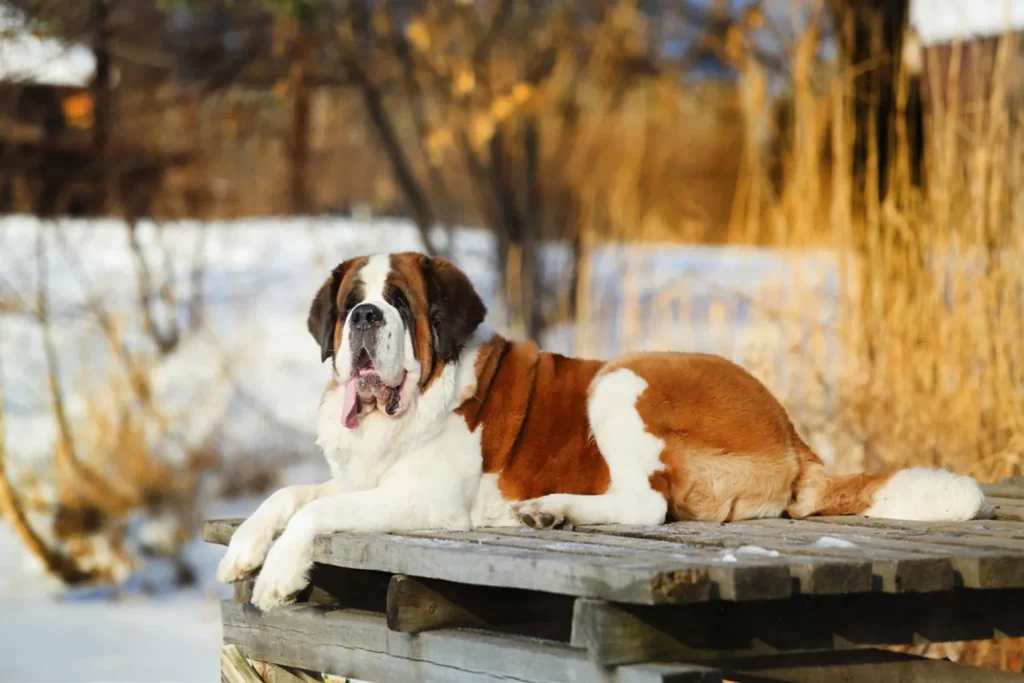
What Is the Average Weight and Height of a Saint Bernard?
Saint Bernards are the definition of gentle giants impressive, cuddly, and absolutely capable of taking over your couch without meaning to. Their size is part of their charm, but it also means it helps to know what’s “normal” when you’re planning for space, food, and, yes, drool towels.
For the numbers: male Saint Bernards typically stand about 70 to 90 cm tall at the shoulder (roughly 27.5 to 35.5 inches) and weigh around 63 to 81 kg (about 139 to 179 pounds). Females are a bit smaller, usually 65 to 80 cm tall (25.5 to 31.5 inches) and around 54 to 63 kg (119 to 139 pounds). They’re considered a giant breed, through and through, with big frames and thick bones to match those big hearts. https://en.wikipedia.org/wiki/St.Bernard(dog_breed)
A quick tip when you’re checking height: measure at the withers the top of the shoulders while your dog is standing square. I remember helping a friend measure her Saint, Moose, and we had to bribe him with treats just to keep still long enough. He leaned on me like a living weighted blanket and I nearly toppled over, which is pretty on brand for a Saint Bernard.
Because of their size, you’ll want to keep an eye on weight as they grow. Slow, steady growth is your friend especially for their joints. If you’re raising a puppy, choose a large breed formula and go easy on the extras, even when those big eyes are begging. An adult Saint who’s fit should have a waist you can see from above and ribs you can feel under a thick coat. Practical prep helps too: a sturdy bed, a non slip mat for those big paws, and a water bowl that doesn’t go skidding across the kitchen. And clear the coffee table one happy tail at Saint Bernard height can redecorate a room in seconds.
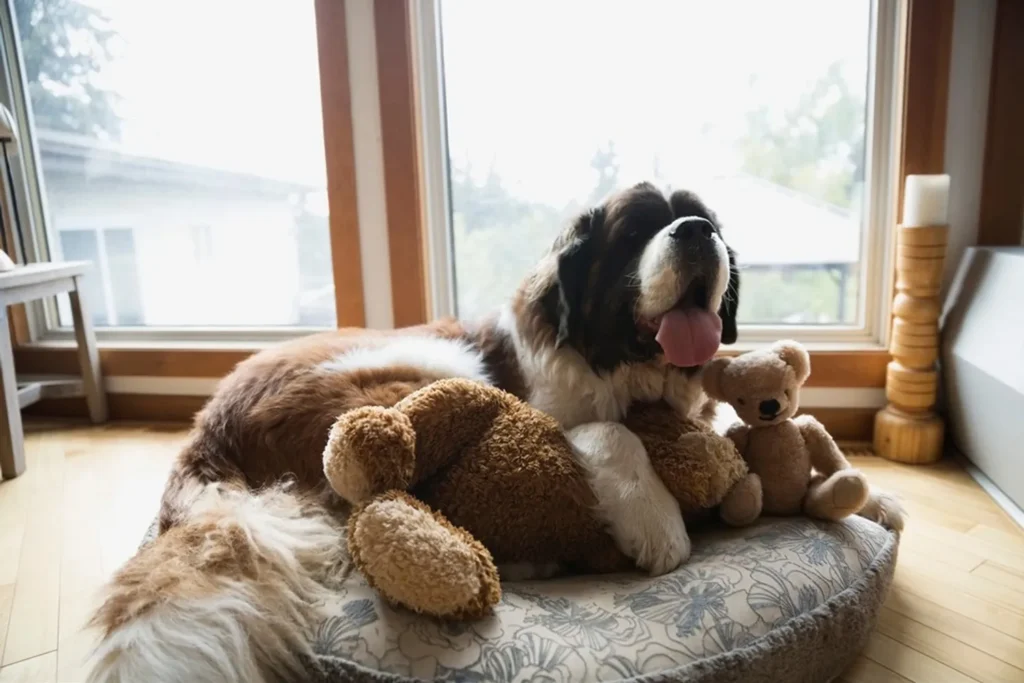
Are Saint Bernards Easy to Train?
I still remember the first Saint Bernard puppy I helped in a beginner class his name was Tank, and he sat beautifully on cue while his giant tail swept three water bowls off the floor like a furry windshield wiper. That sums up Saint Bernard training pretty well: they’re willing, smart, and sweet, but their size makes even the “oops” moments feel extra large. The earlier you start, the easier everything is. Puppy parents should jump into socialization and basic manners as soon as that fluffy bear comes home. Think calm introductions to other dogs and people, plus everyday sights and sounds. A confident, polite Saint starts in puppyhood.
This breed is considered moderately easy to train because they’re intelligent and genuinely want to make you happy. They’re also sensitive, so harsh corrections can shut them down. Positive reinforcement is the way to their big hearts treats, praise, and a cheerful voice go a long way. Keep sessions short and upbeat. I like to end on a win, give a slow ear rub, and call it a day. Tip from experience: have a drool towel handy and use high value treats that don’t crumble. You’ll thank me later.
Because they grow fast (and into absolute units), early obedience is non negotiable. Teach sit, down, stay, leave it, drop it, come, and loose leash walking while they’re still manageable. Practice calm greetings, too. A Saint who learns “four on the floor” won’t accidentally topple Grandma or the neighbor’s toddler. One trick I love: stand on the leash so your pup can’t jump, then reward for sitting to say hello. A sturdy front clip harness helps with polite walking, and a long line is great for practicing recall without risking a surprise sled ride if a squirrel appears.
Socialization isn’t just “meeting lots of dogs.” It’s about positive experiences. Set up playdates with friendly, well mannered pups. Let your Saint explore different surfaces, hear traffic and vacuums, and meet people wearing hats, carrying umbrellas, or using wheelchairs. I also make handling part of training from day one touch paws, look in ears, lift lips so vet visits and grooming are a breeze when they’re 120 pounds of love.
With patience and practice, Saints can be stars in obedience and even dabble in sports. Many enjoy rally, nose work, and traditional draft work like carting or pulling competitions. They love having a job. Just wait until they’re fully grown before doing any serious pulling and keep sessions short and cool these gentle giants can overheat easily. My friend’s Saint, Maple, used to “deliver” garden tools in a tiny wagon and took her job so seriously she’d check on it between reps.
Bottom line: Saint Bernards are biddable and bright, and their desire to please usually outmuscles any stubborn streak. If you’re a first time dog owner, consider a good puppy class or a trainer who uses positive methods you’ll build great habits early. Be consistent, keep it fun, and laugh off the drool. Do that, and you’ll have a well mannered, huggable sidekick who makes training feel like time well spent.
How Do Saint Bernards Behave? Temperament and Personality
If I had to sum up a Saint Bernard in a few words, I’d say: gentle giant with a goofy streak. They aren’t the most active pups on the block, but they have a playful, charming way about them that sneaks up on you like when a 140-pound “lap dog” decides your foot is the perfect pillow. Their natural vibe is calm and warm, the sort of steady presence that makes the whole room exhale. I once sat on a friend’s porch with her Saint Bernard sprawled across our shoes like a living blanket; neighbors stopped to say hello because you just can’t walk past that kind of sweetness without smiling.
Around children, they’re famously patient and careful. I’ve seen little kids build a block castle right next to a Saint Bernard’s tail, and that tail stayed put as if the dog knew it was guarding a masterpiece. They forgive clumsy hugs, tolerate costumes at playtime, and dole out those big, slow tail wags that feel like a friendly drumbeat. That said, size is still size these dogs can accidentally knock a toddler off balance so I always recommend basic training and supervised play, especially while everyone is learning the rhythm of life together.
Despite their mellow nature, they have bursts of playfulness that feel like slow motion zoomies. A game of fetch might last a few tosses before they flop down with a satisfied sigh. They thrive most when they’re included in daily life lounging by your feet while you work, padding along on easy walks, greeting the mail carrier with a curious sniff. What they don’t do well with is being left alone for long stretches. A friend learned this the hard way when her sweet boy, bored and lonely, “reorganized” a pantry shelf. A little puzzle feeder, a mid day check-in, and some quality family time turned that behavior around quickly.
Their protective side is more guardian angel than guard dog. If they sense a threat, you’ll hear a deep, impressive woof and see them step forward with quiet confidence but unnecessary aggression isn’t their style. My neighbor’s Saint Bernard once planted himself between the kids and a loudly rattling delivery cart, tail wagging but posture solid, as if to say, “I’ve got this.” The cart rolled on, and he sauntered back for ear scratches like a hero off duty.
Put it all together kindness, patience, that iconic teddy bear face and it’s easy to see why families adore them. With attention, gentle training, and plenty of together time, a Saint Bernard becomes what they’re meant to be: a loyal, loving companion who turns an ordinary day into something softer and a little more wonderful.
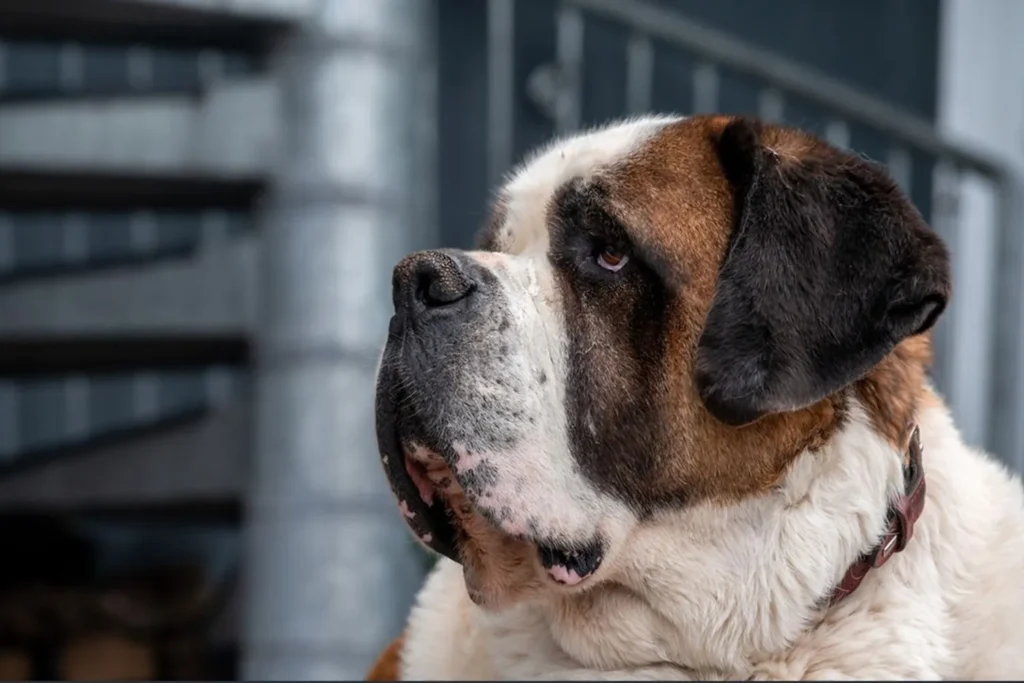
Do Saint Bernards Have Common Health Issues?
Short answer: yes like many giant breeds, Saint Bernards come with a few health quirks worth knowing about. The good news is that being aware of them means you can spot trouble early and keep your big cuddly buddy comfortable for years.
Hip and elbow dysplasia are the big ones. These are developmental issues in the joints that can lead to pain and arthritis. Signs to watch for include stiffness after naps, “bunny hopping” when running, or hesitating to get in the car. Keeping your Saint lean makes a huge difference; extra weight is hard on those joints. I always recommend large breed puppy food for proper growth, non slip rugs on slick floors, and low impact exercise like leisurely walks or swimming. If you’re getting a puppy, ask the breeder about OFA or PennHIP testing for hips and elbows. Joint supplements can help, but I ask my vet before starting anything new.
Osteosarcoma, a type of bone cancer, can show up as a persistent limp or a firm swelling on a leg. It’s more common in older, large breed dogs. A friend’s Saint, Teddy, started favoring one leg after a simple walk turned out it wasn’t a sprain. X rays told the full story. If a limp doesn’t improve within a few days, get it checked. Early veterinary care helps you plan the best path forward for comfort and quality of life.
Gastric dilatation volvulus (bloat) is the emergency everyone with a deep chested dog should know about. The signs are hard to miss: a tight, swollen belly, retching without bringing anything up, drooling, pacing, and obvious distress. This needs immediate vet care. I keep the nearest 24/7 clinic’s number on the fridge and in my phone. Preventive habits help: feed smaller, more frequent meals, use a slow feeder bowl for gulpers, limit vigorous exercise an hour before and after eating, and ask your vet about a preventive gastropexy, which can be done during spay/neuter.
Dilated cardiomyopathy (DCM), a heart condition that weakens the heart’s pumping, can look like tiring easily, coughing, or breathing harder at rest. Regular checkups, especially as they age, are your best friend here; your vet may suggest an echocardiogram if they hear a murmur. Diet can play a role in some dogs, so talk to your vet about the best food and whether taurine testing is appropriate.
Eye issues like entropion and ectropion are also common in Saints. If you see red, irritated eyes, excessive tearing, or squinting, get them looked at. I fostered a Saint named Daisy who had droopy lower lids; we managed with vet prescribed drops until she was old enough for a simple corrective surgery. Keeping the eye area clean helps too.
Not every Saint Bernard will face these problems, but regular vet visits, a healthy weight, sensible exercise, and a bit of planning go a long way. These gentle giants give us so much meeting their needs just comes with the territory of loving a dog the size of a small sofa.

What Is the Lifespan of a Saint Bernard?
It’s the question every giant dog lover asks, and it’s a bittersweet one. Most Saint Bernards live around eight to ten years, which is pretty typical for such a large, slow and steady breed. I remember my neighbor’s Saint, Maple, who would lumber over for ear scratches and then nap on my feet she made it just past her 10th birthday, and every one of those years felt full.
While we can’t stretch the clock, we can absolutely fill it with good days. Keep a Saint Bernard lean to protect those big joints and their heart, schedule regular vet checkups, and stick to gentle daily exercise think shaded strolls and short hikes rather than marathon runs. They can overheat easily, so I love early morning walks and a cool spot to rest. Add comfy bedding, nail trims, some puzzle toys, and lots of calm, cozy family time. A friend’s Saint, Gus, cruised into his 11th year on sensible portions and slow, happy walks. Most of all, take the photos, enjoy the snow days, and celebrate the goofy, drooly moments they’re the best part.
How Much Should a Saint Bernard Eat?
Feeding a Saint Bernard is a bit like fueling a small, gentle bear there’s a lot of dog to support, but you still want to keep things balanced and easy on their big bones and joints. I always start by looping in a trusted veterinarian or a canine nutritionist to tailor a plan. Every Saint is different, and the right diet can make a huge difference in how they grow, move, and feel.
When you’re choosing food, look for brands that meet WSAVA guidelines and carry the AAFCO statement saying the diet is complete and balanced for your dog’s life stage. That label tells you the basics are covered. For puppies, it’s especially important to use a giant breed puppy formula. These diets are designed to support steady growth and proper bone development slow and steady really wins the race with Saints. And one more critical point: avoid grain free diets for this breed. Saints are already prone to heart issues, and grain free formulas have been linked to dilated cardiomyopathy in dogs. My vet sat me down with an article about it when my friend brought home her Saint pup, and it was an easy decision to stick with well tested, grain inclusive foods.
Most adult Saints do well on two meals a day. How much you scoop depends on your dog’s size, age, metabolism, and activity level. I like using a measuring cup or, better yet, weighing the food so I’m not accidentally overdoing it. Keep an eye on body condition rather than the number on the scale: you should be able to feel ribs with a light touch (but not see them), and there should be a visible waist when you look from above. If your Saint is more couch potato in winter and mountain explorer in summer, adjust portions accordingly.
Treats are fine in moderation, especially during training. I break treats into tiny pieces so I can reward often without piling on extra calories. One time I realized my Saint had basically eaten a second dinner in “training snacks” lesson learned. Count treats as part of the daily intake, and skip table scraps. Not only can people food upset their stomach or add unnecessary fat, it turns even the politest Saint into a world-class beggar. Fresh water should be available at all times mine is a champion drooler, so I keep a towel handy and an absorbent mat under the bowl.
Like many large, deep chested breeds, Saints can be at risk for bloat (gastric dilatation and volvulus, or GDV). To help, offer smaller, more frequent meals if your dog tends to inhale food, and consider slow feeder bowls or puzzle feeders to encourage a calm pace. I also give a little quiet time before and after meals instead of diving straight into fetch. Ask your vet about other preventive tips and make sure you know the signs of bloat and where your nearest emergency clinic is peace of mind goes a long way.
With the right diet and routine, your Saint will have the energy to be their lovable, lumbering self without overtaxing their body. And that’s the sweet spot we’re all aiming for.
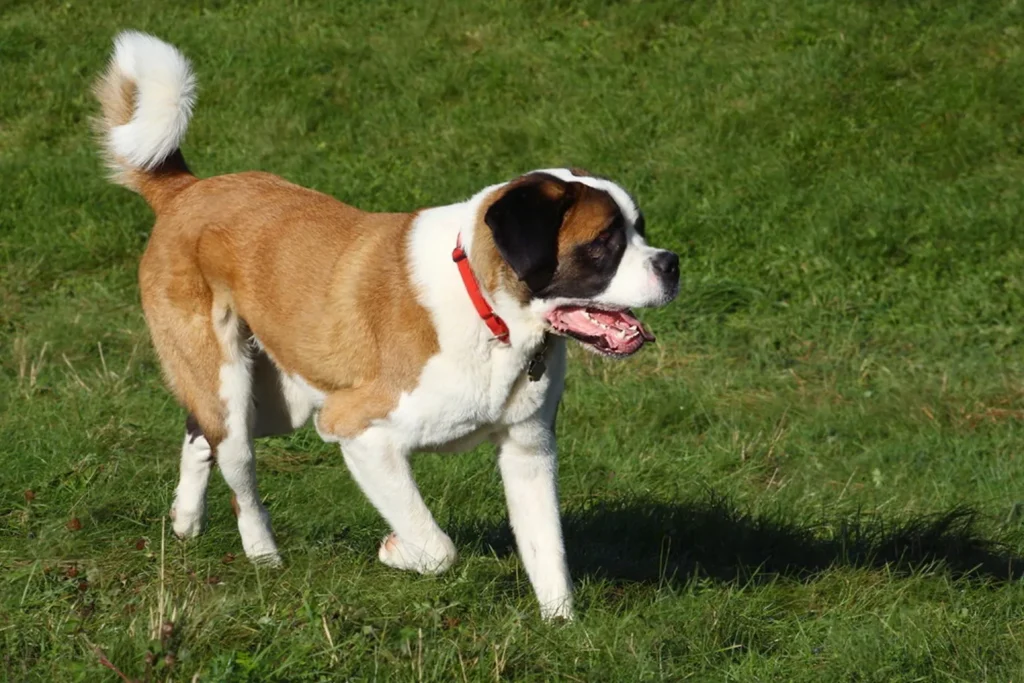
Saint Bernard FAQs
Are Saint Bernards outside dogs?
Saint Bernards are happiest glued to their people. They really aren’t suited to living outdoors, and in warm climates they can overheat surprisingly fast. I learned that quickly with a neighbor’s Bernie who would press his nose to the window until someone let him in to flop on the cool kitchen floor. Plan on at least 30 minutes of outdoor exercise every day, split into a couple of gentle walks or a stroll and some sniff time in the yard. In summer, go early morning or evening, bring water, and stick to shade. Even though they handle cold better than heat, I still don’t leave them outside for long stretches these big softies want family time more than anything.
How many puppies can a Saint Bernard have?
Most Saint Bernards have litters of about 6 to 8 puppies, though you’ll sometimes see smaller or larger litters depending on the mom’s age, health, and genetics. A friend’s girl surprised everyone with nine healthy pups; another had just four, each one a chunky marshmallow. Regular veterinary care during pregnancy is essential think prenatal checkups, guidance on nutrition, and a plan for whelping day. If you’re involved, set up a roomy whelping area, have supplies ready, and keep your vet on speed dial. Big puppies mean tired moms, so a little human support goes a long way.
Are Saint Bernards ideal for a first time dog owner?
They can be, but only if you’re genuinely committed to training and management. Their size and strength are no joke one enthusiastic lunge toward a squirrel once dragged me three steps like I was waterskiing on the sidewalk. Early training, puppy classes, and consistent leash manners are nonnegotiable. I also recommend sturdy gear, a routine for polite greetings (they love to lean), and a plan for drool management keep towels handy. If you’re willing to work with a good trainer and stay consistent, a Saint can be a wonderful first dog. If not, the learning curve can feel steep.
Are Saint Bernards hypoallergenic dogs?
Nope. With their heavy shedding, Saint Bernards are definitely not hypoallergenic. Expect dander, tumbleweeds of fur, and a little slobber seasoning on your sleeve. If allergies are a concern, spend time with an adult Saint before committing. A solid grooming routine helps regular brushing, frequent vacuuming, and maybe an air purifier but it won’t make them allergy friendly. Better to know that now than after you’ve fallen for those soulful eyes.
Disclaimer:
This article is for informational purposes only and doesn’t replace professional veterinary or training advice. Always consult a certified vet or dog trainer for guidance specific to your pup.

